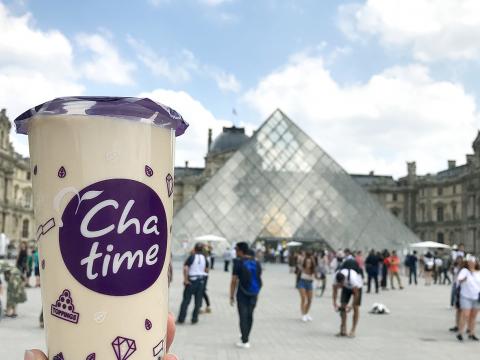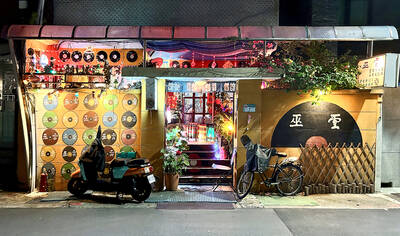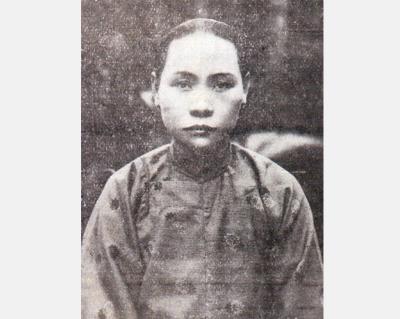Bubble tea, also called pearl tea (珍珠奶茶), is a quintessentially Taiwanese drink, but how old is the chewy tapioca ball-filled beverage, who invented it and how did it become to be so popular?
The origins of bubble tea are steeped in mystery and still hotly debated, but according to the orthodox version of events, the story begins in 1980s Taiwan.
At the time something called “bubble tea” — quite different from the drink we know today — was all the rage. Made with either black tea or green tea, brewed tea was sweetened with sugar syrup and then shaken through ice in a cocktail shaker to both chill the tea and produce a copious amount of bubbly froth at the top of the glass, similar to a “head” on a freshly poured pint of beer. The shaking was initially done by hand, but later machines were developed to automatically agitate the tea mixture.

Photo: Yang Ya-min, Taipei Times
At some point, chewy tapioca balls (粉圓) were added to bubble tea, resulting in pearl milk tea, the familiar drink we know today. Two rival Taiwanese teahouse chains — Hanlin Tea Room (翰林茶館) in Tainan and Chun Shui Tang (春水堂人文茶館) in Taichung — lay claim to conceiving the bubbly beverage.
DISPUTE OVER ORIGINS
Hanlin Tea Room insists it came up with the idea in 1986 when its founder Tu Tsung-ho (?宗和) spotted white-colored tapioca balls on sale at Tainan’s Yamuliao market. Tu had a sudden flash of inspiration and bought some of the balls home, and after cooking them through, added them to some milk tea. He found the texture pleasing and soon christened the new beverage pearl milk tea on account of the pearly, semi-translucent white tapioca balls. To this day, customers at any branch of Hanlin Tea Room can choose between either the original white tapioca balls or the more common black variety, made with brown sugar.

Photo Courtesy of Cha Cha The
However, Chun Shui Tang maintains it is the true inventor of the beverage, which it says was created by a then-20-year-old female employee, Lin Hsiu-hui (林秀慧), the following year in 1987. One day at the teahouse, Lin experimented by mixing her favorite childhood snack, tapioca balls, with iced milk tea and also lemon black tea to produce what the company claims was the world’s first cup of pearl milk tea.
The two companies became locked in a bitter dispute, filing lawsuits against each other and eventually going to court to settle the matter. However, since neither one was able to successfully patent or trademark their product, by the mid-1990s, pearl milk tea featured on the menus of Taiwan’s teahouses, which were popular hangouts for students and businessmen to relax and chew the cud in the days before the influx of coffee shops. With the introduction from abroad of machines that automatically seal the top of takeaway cups with a thin film of plastic, the modern takeaway version of the beverage was born.
ANOTHER THEORY
However, there is an intriguing alternative explanation: bubble tea’s earliest incarnation could in fact be traced back to the days of the British empire. In British Malaya (modern-day Singapore and Malaysia) an iced drink/desert, usually called cendol or chendol, began to be drunk to provide respite from the tropical heat.
Brightly-colored, worm-like gelatinous strands, usually made from rice flour or sago, are added to coconut milk which has been sweetened with sugar and combined with ice to make a refreshing drink or iced snack. It is thought that cendol may have been inspired by locals observing British expatriates adding milk to their tea and may have originated in port cities such as Malacca or Penang, where refrigeration technology from British ships would have provided the ice. Today, Cendol is a ubiquitous thirst-quencher drunk across South East Asia, including Thailand, Vietnam and Indonesia and when served in a tall glass, bears an uncanny resemblance to Taiwan’s bubble tea.
Meanwhile, chewy tapioca balls, called fenyuan in Chinese, somehow made their way to Taiwan from abroad — possibly via China, after being presented to Empress Dowager Cixi (慈禧太后) as tribute — and began to be used as an ingredient in sweet snacks at Taiwanese night markets. Contrary to the competing claims of the teahouses, perhaps the real origin of bubble tea is to be found in Taiwan’s night markets, possibly inspired by a Taiwanese night market vendor sipping on a glass of cendol during a trip to Singapore or Malaysia.
Whatever the true origin of bubble tea, today takeaway tea shops abound on almost every street corner and rival chains fiercely compete for business, continually innovating wacky new flavor combinations and textures to keep customers coming back for more. In recent years, Taiwan’s quasi-national beverage has successfully seen off the coffee juggernaut as well as multiple food safety scares and looks set to stay a permanent fixture of Taiwan’s culinary scene for many years to come.

The Lee (李) family migrated to Taiwan in trickles many decades ago. Born in Myanmar, they are ethnically Chinese and their first language is Yunnanese, from China’s Yunnan Province. Today, they run a cozy little restaurant in Taipei’s student stomping ground, near National Taiwan University (NTU), serving up a daily pre-selected menu that pays homage to their blended Yunnan-Burmese heritage, where lemongrass and curry leaves sit beside century egg and pickled woodear mushrooms. Wu Yun (巫雲) is more akin to a family home that has set up tables and chairs and welcomed strangers to cozy up and share a meal

Dec. 8 to Dec. 14 Chang-Lee Te-ho (張李德和) had her father’s words etched into stone as her personal motto: “Even as a woman, you should master at least one art.” She went on to excel in seven — classical poetry, lyrical poetry, calligraphy, painting, music, chess and embroidery — and was also a respected educator, charity organizer and provincial assemblywoman. Among her many monikers was “Poetry Mother” (詩媽). While her father Lee Chao-yuan’s (李昭元) phrasing reflected the social norms of the 1890s, it was relatively progressive for the time. He personally taught Chang-Lee the Chinese classics until she entered public

Last week writer Wei Lingling (魏玲靈) unloaded a remarkably conventional pro-China column in the Wall Street Journal (“From Bush’s Rebuke to Trump’s Whisper: Navigating a Geopolitical Flashpoint,” Dec 2, 2025). Wei alleged that in a phone call, US President Donald Trump advised Japanese Prime Minister Sanae Takaichi not to provoke the People’s Republic of China (PRC) over Taiwan. Wei’s claim was categorically denied by Japanese government sources. Trump’s call to Takaichi, Wei said, was just like the moment in 2003 when former US president George Bush stood next to former Chinese premier Wen Jia-bao (溫家寶) and criticized former president Chen

President William Lai (賴清德) has proposed a NT$1.25 trillion (US$40 billion) special eight-year budget that intends to bolster Taiwan’s national defense, with a “T-Dome” plan to create “an unassailable Taiwan, safeguarded by innovation and technology” as its centerpiece. This is an interesting test for the Chinese Nationalist Party (KMT), and how they handle it will likely provide some answers as to where the party currently stands. Naturally, the Lai administration and his Democratic Progressive Party (DPP) are for it, as are the Americans. The Chinese Communist Party (CCP) is not. The interests and agendas of those three are clear, but